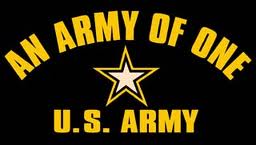 Many of you may remember seeing the following TV commercial several years ago: A soldier is running alone across the desert, carrying a backpack but no rifle. Helicopters swoop overhead. A squad of soldiers runs past, moving in the direction opposite of the lone runner. Voiceover: “Even though there are 1,045,690 soldiers like me, I am my own force. . . . The might of the U.S. Army doesn’t lie in numbers. It lies in me. I am an Army of One.”
Many of you may remember seeing the following TV commercial several years ago: A soldier is running alone across the desert, carrying a backpack but no rifle. Helicopters swoop overhead. A squad of soldiers runs past, moving in the direction opposite of the lone runner. Voiceover: “Even though there are 1,045,690 soldiers like me, I am my own force. . . . The might of the U.S. Army doesn’t lie in numbers. It lies in me. I am an Army of One.”
For those of us serving in the military, this seemed a particularly odd recruiting slogan. With very few exceptions, the image of a warrior acting alone is far from the reality we either espouse or embrace. Our strength, we know, is in numbers. In always knowing that help is never far behind.
The idea that we are stronger together is reinforced every day in the military. Take, for example, even some of the more mundane practices, such as parade-ground drills, formation runs, and training projects geared to collective problem solving. All are intentionally designed to reinforce that every individual is simply one part of a larger group at work. Be it a squad, flight, platoon, company, squadron, battalion or wing, no one who chooses to wear the uniform of the nation ever feels as though they fight alone.
Eventually, senior military leaders recognized the “Army of One” slogan missed the mark. In early October of 2006, the Army unveiled its replacement slogan: “Army Strong.” The result of numerous focus groups and interviews with soldiers, it is designed to convey the idea that joining the Army will help someone gain not only physical and emotional strength, but strength of character and purpose as well. It is, in many ways, more congruent with one of the timeless truths associated with responsible service: we are at our best when we willfully join our unique gifts, talents, skills and strengths with those around us in support of a worthwhile cause.
The point of my sharing this story with you is quite simple. There are many times as leaders when we get so caught up pursuing our own agendas that we trick ourselves into believing we can somehow succeed on our own. The fact of the matter is no leader is good enough to be an army of one. True strength comes from layering our individual gifts, abilities and talents with those of others.
Retired General Stanley McChrystal, former Commander of U.S. Forces in Afghanistan, likes to speak about the value of seeking strength in numbers by using an unlikely analogy: plywood. Plywood, he reminds us, is made up of several layers of wood that, individually, are not very strong. However, when we combine several thin layers of timber, and bond them together, the resulting product is strong, durable and very resistant to cracking and warping. In a word, the collective pieces of wood are now more resilient.
The great wisdom book, Ecclesiastes, speaks to the truth that we are never as strong alone as we are when we willfully join our efforts to those of others: “Two are better than one, because they have a good return for their labor: if either of them falls down, one can help the other up. But pity anyone who falls and has no one to help them up.”
So the next time you find yourself acting like an Army of One, take heed. True strength isn’t something you only find within you. It’s something you fully realize when you combine your best with those around you.

Sir…just ran across your blog at generalleadership.com. This post was “spot on” for its focus on the military’s emphasis on people. This is why we value loyalty so much. Keep up the good work. Thanks.
Doug
http://www.theleadermaker.com